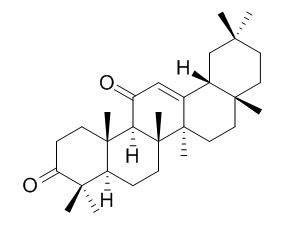Olean-12-ene-3,11-dione
Inquire / Order:
manager@chemfaces.com
Technical Inquiries:
service@chemfaces.com
Tel:
+86-27-84237783
Fax:
+86-27-84254680
Address:
1 Building, No. 83, CheCheng Rd., Wuhan Economic and Technological Development Zone, Wuhan, Hubei 430056, PRC
Providing storage is as stated on the product vial and the vial is kept tightly sealed, the product can be stored for up to
24 months(2-8C).
Wherever possible, you should prepare and use solutions on the same day. However, if you need to make up stock solutions in advance, we recommend that you store the solution as aliquots in tightly sealed vials at -20C. Generally, these will be useable for up to two weeks. Before use, and prior to opening the vial we recommend that you allow your product to equilibrate to room temperature for at least 1 hour.
Need more advice on solubility, usage and handling? Please email to: service@chemfaces.com
The packaging of the product may have turned upside down during transportation, resulting in the natural compounds adhering to the neck or cap of the vial. take the vial out of its packaging and gently shake to let the compounds fall to the bottom of the vial. for liquid products, centrifuge at 200-500 RPM to gather the liquid at the bottom of the vial. try to avoid loss or contamination during handling.
J Med Food.2019, 22(10):1067-1077
Sci Rep.2018, 8(1):12970
Chem Biol Interact.2024, 395:110999.
Journal of Functional Foods2019, 52:430-441
Pak J Pharm Sci.2019, 32(6):2879-2885
Natural Product Communications2020, doi: 10.1177.
Antioxidants (Basel).2023, 12(7):1324.
J Biochem.2024, 175(3):253-263.
Sci Rep.2017, 7:467-479
J Chromatogr A.2017, 1518:46-58
Related and Featured Products
Environmental Chemistry, 2016, 13(4):732.
Oxidation products of α- And β-amyrins: Potential tracers of abiotic degradation of vascular-plant organic matter in aquatic environments.[Reference:
WebLink]
Environmental contextHow can we know what happens to organic matter in aquatic environments? Although several compounds exist that can be used to trace the origin and state of organic matter, not many are sufficiently stable and specific to trace degradation processes, but α- and β-amyrins can fulfil that role. Such knowledge will help us better understand and better quantify carbon fluxes in riverine and marine environments.
METHODS AND RESULTS:
AbstractIn order to fulfil the current need for stable and specific tracers to monitor vascular-plant organic matter degradation in aquatic environments, α-amyrin (urs-12-en-3β-ol) and β-amyrin (olean-12-en-3β-ol) were oxidised in vitro and their abiotic degradation products quantified in environmental samples from the Rhône River in France. Although they appear inert to photooxidation, they are clearly affected by autoxidation and the tracer potential of the resulting products was confirmed. Autoxidation of α- and β-amyrins produces urs or olean-12-en-3-one, 3β-hydroxy-urs or olean-12-en-11-one, urs or olean-12-en-3β,11α-diol and urs or Olean-12-ene-3,11-dione. 3β-Hydroxy-urs-12-en-11-one and 3β-hydroxy-olean-12-en-11-one, the main oxidation products detected, were selected as autoxidation tracers.
CONCLUSIONS:
These compounds, specific to autoxidation, were detected in dry leaves of Smilax aspera and in suspended particulate matter samples collected in the Rhône River and evidenced the importance of autoxidation in the degradation of organic matter of terrestrial origin.
Glyasperin C
Catalog No: CFN95065
CAS No: 142474-53-1
Price: $333/10mg
3,7,23,24-tetrahydroxycucurbita-5,25-dien-19-al
Catalog No: CFN95168
CAS No: 1446447-97-7
Price: $318/5mg
(+)-Lariciresinol 4'-O-beta-D-Glucopyranosyl-(1->3)-beta-D-glucopyranoside
Catalog No: CFN95283
CAS No: 639857-95-7
Price: $463/5mg
3-Oxo-4-benzyl-3,4-dihydro-1H-pyrrolo [2,1-c] oxazine-6-methylal
Catalog No: CFN95293
CAS No: 60026-28-0
Price: $413/5mg
8'-O-(3-hydroxy-3-methylglutaryl)-8'-hydroxyabscisic acid
Catalog No: CFN95308
CAS No: 69790-31-4
Price: $318/5mg
Batatasin IV
Catalog No: CFN95319
CAS No: 60347-67-3
Price: $318/5mg
(2S)-5,7,3',4'-tetramethoxyflavanone
Catalog No: CFN95406
CAS No: 74628-43-6
Price: $318/10mg
3-Hydroxymollugin
Catalog No: CFN95424
CAS No: 154706-45-3
Price: $368/5mg
8-Hydroxy-5,7-dimethoxyflavanone
Catalog No: CFN95580
CAS No: 201230-40-2
Price: $318/5mg
Methyl ganoderate E
Catalog No: CFN95582
CAS No: 98718-43-5
Price: $413/5mg



